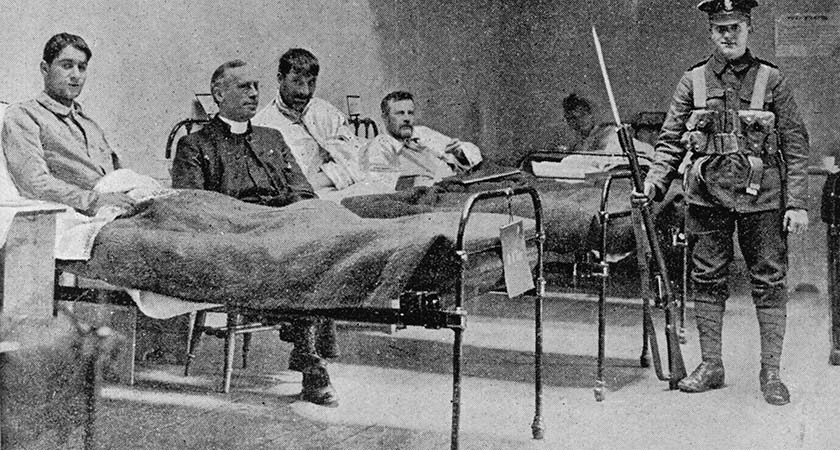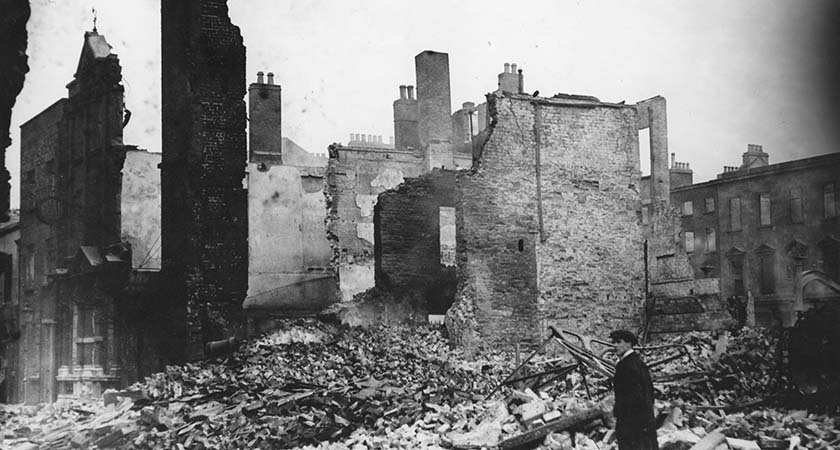1. Irish units throughout Dublin were the first British Army troops to respond to the outbreak of the rebellion. The 10th Royal Dublin Fusiliers, 3rd Royal Irish Regiment, and 3rd Royal Irish Rifles all sent columns of men towards Dublin Castle as soon as the alarm was raised.
2. Irishmen were therefore some of the first British Army soldiers to die during the Rising. When these columns of troops encountered the rebels and were fired on, one of the first British Army soldiers to be shot and killed was Lieutenant Gerald Neilan of the 10th Royal Dublin Fusiliers. Thirty-four years old and from Ballygalda, County Roscommon, he was a passionate Irish nationalist. Ironically, his younger brother Arthur fought with republican forces during the Easter Rising.
3. Irishmen made up 35 per cent of the British military fatalities incurred during the Rising (41 out of the 117 military deaths) and 29 per cent of the wounded (106 out of the 357 military wounded).
4. The three Irish units of the British Army stationed in Dublin when the Rising began contained 1,541 men between them, most of them Irish. On day one, the republican forces numbered 700, but later grew to about 1,400.
5. Several of the republican leaders of the Easter Rising had strong links to the British Army. James Connolly and Michael Mallin had both previously served as regular soldiers in the British Army (Connolly’s brother John was still serving at the time of the Rising). Éamonn Ceannt had a brother in the British Army at the time of the rebellion, who would later be killed in action on the Western Front. Meanwhile, both Tom Clarke and Roger Casement had fathers who had served in the British Army.
6. Tragically, many of the Irishmen who were serving in the British Army at the time of the Rising, and the men of the Irish Volunteers who they found themselves fighting against, had been friends and allies before the Irish Volunteers split in 1914 over the issue of supporting the British war effort.
7. During the Rising, several Irish civilians were summarily executed by a mentally unstable British Army officer named Captain John Bowen-Colthurst. Hanna Sheehy-Skeffington, the wife of one of the murdered men – Francis Sheehy-Skeffington, a well-known Irish pacifist – later referred to Captain Bowen-Colthurst as ‘simply the Englishman with the veneer removed.’ The truth was that Bowen-Colthurst was an Irishman from County Cork.
8. A ‘Dad’s Army’-style home defence force was active in Dublin at the time of the Rising. Predominantly comprised of elderly Irishmen, the force was officially called the Georgius Rex – Latin for King George. However, Dublin wit had quickly turned this into the ‘Gorgeous Wrecks’ or ‘God’s Rejected’, and they were also known as ‘The Methuseliers’. When they heard word of the rebellion during the afternoon of 24 April 1916, they quickly marched back into Dublinbut they marched right into a rebel ambush on Northumberland Road. The great tragedy was the fact that they had no ammunition for their outdated rifles. They could not defend themselves – many were also too old to jump over garden walls to safety – and the force suffered several killed and wounded before the rebels realised who they were shooting at and held their fire.
9. Captain John Esmonde was an Irish officer serving with the 10th Royal Dublin Fusiliers in Dublin during the Easter Rising; he was also an MP at the time. Following Irish independence, he later became involved in Irish politics and went on to serve as a Fine Gael TD (MP) in Dáil Éireann (Irish Parliament) – with a four year absence – from 1937 until 1951. At one point in 1948, during talks in advance of the formation of the first inter-party government in Ireland, he was even put forward as a possible candidate for Taoiseach (Irish Prime Minister). The reason for this: he had had no involvement with either side during the Irish Civil War of 1922-23.
10. The last surviving combatant of the Easter Rising was an Irishman who served in the British Army throughout the rebellion. Fred Watson, from Rathdrum, County Wicklow, served with 4th Royal Dublin Fusiliers during the Rising and was even awarded a Mention in Dispatches for his actions. Shortly after, it was discovered that he was only sixteen years old, and so he was discharged for being underage. However, when he was old enough he re-enlisted and served out the remainder of WW1 in the Tank Corps. He passed away on 31 March 1997, aged ninety-seven.




